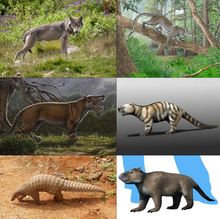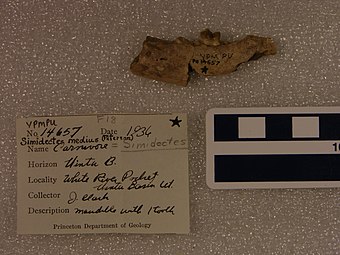Ferae
| Ferae | |
|---|---|

| |
| Scientific classification | |
| Domain: | Eukaryota |
| Kingdom: | Animalia |
| Phylum: | Chordata |
| Class: | Mammalia |
| Grandorder: | Ferungulata |
| Mirorder: | Ferae Linnaeus, 1758[2] |
| Subgroups | |
|
[see classification]
| |
| Synonyms | |
Ferae (
General characteristics
In mirorder Ferae
The common feature for members of this mirorder is ossified
Thinocyon medius
In clade Pan-Carnivora
The common features for members of clade Pan-Carnivora are:
- heterodont teeth that are sharp and for cutting meat,
- canine teeth that are usually large, conical, pointed, thick and stress resistant,
- and presence of the carnassial teeth.
Carnassials are feature that allows distinguishing the
Classification and phylogeny
Sister groups to Ferae and position of pangolins and creodonts
According to recent studies (reflected in the diagram below), the closest living relatives of Ferae are members of mirorder
An alternate phylogeny holds that the closest relatives to the Ferae are the Perissodactyla and
While there has been strong support in the inclusion of order
Taxonomy
Traditional classification: Revised classification: - Mirorder: Ferae (Linnaeus, 1758)
- Clade: Pan-Carnivora (Flynn, Wyss & Wolsan, 2020)[31]
- Clade: Carnivoramorpha (Wyss & Flynn, 1993) (carnivorans and stem-relatives)
- Order: †Hyaenodonta (Van Valen, 1967)
- Order: †Oxyaenodonta (Van Valen, 1971)
- Family: †Oxyaenidae (Cope, 1877)
- Family: †Wyolestidae (Gingerich, 1981)
- Genus: †Simidectes (Stock, 1933)
- (unranked): †Altacreodus/Tinerhodon clade
- Genus: †Altacreodus (Fox, 2015)
- Genus: †Tinerhodon (Gheerbrant, 1995)
- Clade: Pholidotamorpha (Gaudin, 2009)
- Order: Pholidota (Weber, 1904) (pangolins)
- Order: †Palaeanodonta (Matthew, 1918) (stem-pangolins)
- Clade: Pan-Carnivora (Flynn, Wyss & Wolsan, 2020)[31]
- Mirorder: Ferae (Linnaeus, 1758)
Alternative classification and possible fossil members
In Halliday et al. (2015) various enigmatic Palaeocene mammals have been proposed to be possible members to Ferae, like members of orders
See also
References
- ^ a b Sean P. Heighton, Rémi Allio, Jérôme Murienne, Jordi Salmona, Hao Meng, Céline Scornavacca, Armanda D. S. Bastos, Flobert Njiokou, Darren W. Pietersen, Marie-Ka Tilak, Shu-Jin Luo, Frédéric Delsuc, Philippe Gaubert (2023.) "Pangolin genomes offer key insights and resources for the world’s most trafficked wild mammals"
- ^ "'Ferae' – The Linnean Collections". linnean-online.org. Retrieved 26 February 2020.
- ^ Haeckel, Ernst (1866.) "Generelle Morphologie der Organismen." Berlin: Georg Reimer.
- ^ Haeckel, Ernst (1895). Systematische Phylogenie: Wirbelthiere (in German). Vol. T.3. Berlin: G. Reimer.
- ^ Zagorodniuk, I. (2008.) "Scientific names of mammal orders: from descriptive to uniform" Visnyk of Lviv University, Biology series, Is. 48. P. 33-43
- ^ Kalandadze, N. N. and S. A. Rautian (1992.) "Systema mlekopitayushchikh i istorygeskaya zoogeographei [The system of mammals and historical zoogeography]." Sbornik Trudov Zoologicheskogo Muzeya Moskovskogo Goschdarstvennoro Universiteta 29:44–152.
- ^ Edward Newman (1843.) "The Zoologist: a monthly journal of natural history. (Vol. 1)", London, J. Van Voorst
- PMID 12878460.
- ^ a b McKenna, M. C. (1975). "Toward a phylogenetic classification of the Mammalia". In Luckett, W. P.; Szalay, F. S. (eds.). Phylogeny of the Primates. New York: Plenum. pp. 21–46.
- ^ Malcolm C. McKenna, Susan K. Bell: Classification of Mammals: Above the Species Level in Columbia University Press, New York (1997), 631 Seiten. Ferae
- ^ a b c Floréal Solé & Thierry Smith (2013.) "Dispersals of placental carnivorous mammals (Carnivoramorpha, Oxyaenodonta & Hyaenodontida) near the Paleocene-Eocene boundary: a climatic and almost worldwide story" Geologica Belgica 16/4: 254–261
- S2CID 214085088, retrieved 26 February 2020
- PMID 17101039.
- PMID 21900649. (Advance Access; published online 7 September 2011)
- PMID 16785431.
- PMID 17101283.
- PMID 17661234.
- PMID 17440620.
- PMID 21900649.
- S2CID 9133016.
- PMID 3127652.
- ISBN 978-1-4899-0539-0.
- S2CID 4398233.
- S2CID 34367609.
- ^ PMID 28075073.
- doi:10.26879/776.
- S2CID 46774007.
- ^ Prevosti, F. J., & Forasiepi, A. M. (2018). "Introduction. Evolution of South American Mammalian Predators During the Cenozoic: Paleobiogeographic and Paleoenvironmental Contingencies"
- S2CID 145972918.
- S2CID 219585388.
- ^ J. J. Flynn, A. R. Wyss and M. Wolsan (2020.) "Pan-Carnivora, new clade name" In book: Phylonyms (pp.979–982)
- S2CID 86402154.
- ^ Frank Zachos (2020.) "Mammalian Phylogenetics: A Short Overview of Recent Advances", In book: "Mammals of Europe – Past, Present, and Future" (pp.31–48)
- ^ Xue Lv, Jingyang Hu, Yiwen Hu, Yitian Li, Dongming Xu, Oliver A. Ryder, David M. Irwin, Li Yu (2021.) "Diverse phylogenomic datasets uncover a concordant scenario of laurasiatherian interordinal relationships", Molecular Phylogenetics and Evolution, Volume 157







